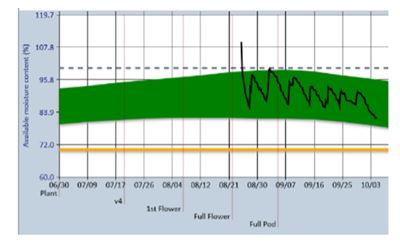Irrigation Scheduling Using Soil Moisture Sensors
RICK DELOUGHERY
CHARLESTON, MO.
There is an old saying, “You cannot manage well what you do not measure.” This also applies to managing soil moisture in an irrigated crop. There are several ways to measure or keep track of soil moisture.
One way is to use electrical soil moisture sensors. Another is to calculate water use based on weather sensors from a nearby station. To probe the soil two or more feet deep and estimate moisture by its feel does work, but is generally less accurate and labor intensive. I know, I did this as a crop consultant.
For years Bootheel irrigators have been encouraged to use the University of Missouri Woodruff Charts or the Arkansas Scheduler for scheduling irrigation. The Woodruff Charts use historic averages of crop water use, which the farmer then has to estimate how to vary applications based on current weather. The Arkansas Scheduler software enables a user to periodically account for current weather and irrigation data, so this should be more accurate.
Table 1 shows the increased yields Bootheel irrigators have reported according to their irrigation scheduling method. In this survey, use of soil moisture sensors was only reported by 1 percent of corn growers and 1 percent of cotton growers. Most of the yield increase probably resulted from using sensors.
Electrical soil moisture sensors connected to a wireless cell phone transmitter enable an irrigator to remotely monitor the amount of soil moisture in a field. Most sensor and irrigation service companies now offer this wireless capability. Figure 1 shows a typical pattern of soil moisture use and recharge that was recorded by a sensor in an irrigated soybean crop, graphed automatically, and available to the farmer at any time of day.
To properly use soil moisture sensors on center pivots at least three locations should be monitored to account for distribution differences in the pivot. Experts recommend that each location have sensors at 6-, 12-, and 18-inch depths, and be installed early in the season.
There are two types of electrical moisture sensors of modest cost, ease of use, and reliability. One type uses electrical resistance, like gypsum blocks, and the other type uses capacitance sensors. Both types work well.
Other components of a soil moisture sensor station in a field include a datalogger and a cell phone connection to send the data to an internet site periodically through the day. Some companies provide additional, lower-cost sensor stations that send a signal to this datalogger, which reduces cost somewhat. Some companies provide signals that go directly to the farmer’s computer or smartphone.
Loss of this signal or connection to the cell tower has been a problem. Most companies have solved this issue and know the limits of their equipment. Each site needs to be evaluated for signal. Low areas or sites where a signal needs to go through a row of trees may need a longer antenna or other solution.
Information from two local providers indicate a one-station system can be purchased for $1500 to $1700. Spread over three-years, the annual per-acre cost of this setup would be $5 to $5.70 per acre for a 100 acre field, or $3.90 to $4.30 per acre a 130 acre field. One provider will lease a system for $1000 / year for three years, and the farmer owns it at the end. One manufacturer has a sensor and cell phone in a single unit for under $500.
Comparing these costs to the yield increases farmers reported in Table 1 shows that this investment could pay for itself year after year.
A list of soil moisture sensor manufacturers and local service providers in the Bootheel will soon be up on our website: http://extension.missouri.edu/mississippi. Other irrigation management resources can be found at: http://crops.missouri.edu/irrigation/ and http://extension.missouri.edu/scott/Irrigation.aspx
Experts recommend that farmers not rely on just one system for scheduling irrigation. A soil probe to check soil in other locations in the field is always a good back-up. Another is to use a current-weather computer application as has been developed by University of Missouri Extension Specialist Dr. Gene Stevens at the Fisher Delta Research Center at Portageville, MO. This will be explained in a future article.
For more information on many issues you are dealing with, call Mississippi County Extension at 573-683-6129. To find research-based information on the internet, always include the word “Extension” in the search line. Mississippi County Extension office is at 109 N. First St. in Charleston. ∆
RICK DELOUGHERY: Regional Agronomist and County Program Director, Mississippi County, University of Missouri


Figure 1. A late-season record of soil moisture by an Aqua-Spy sensor in a
Mississippi County, Mo. field in 2015. Each upward direction of the line represents
an irrigation or rain event.